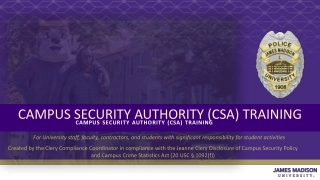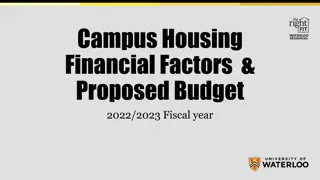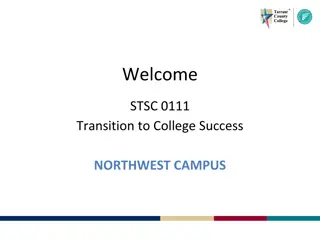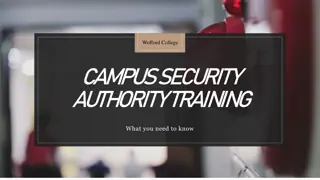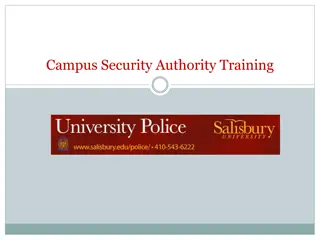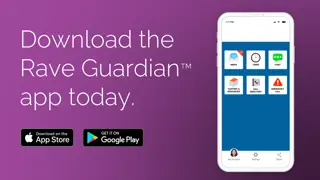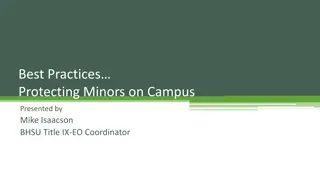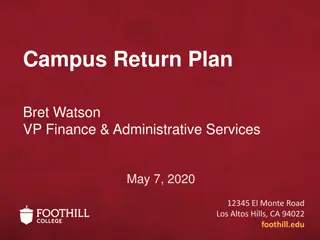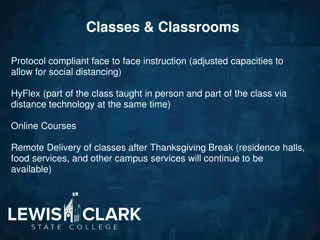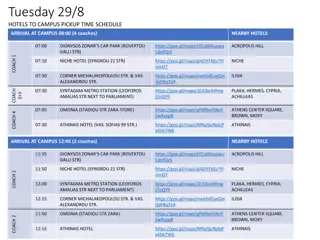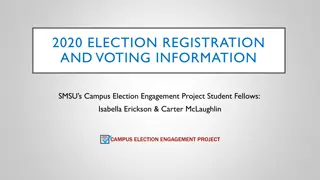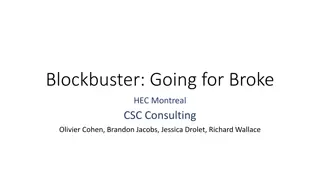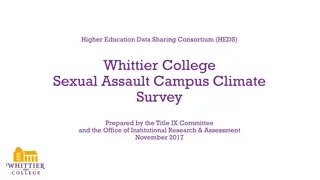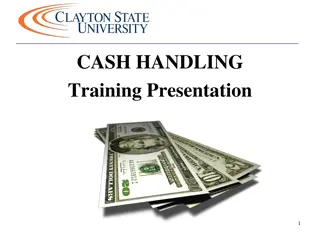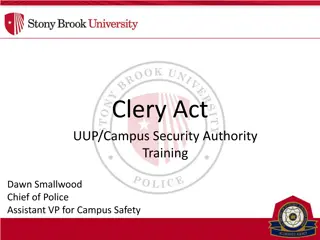Proactive Steps for Handling Disruption on Campus
Strategies for identifying and addressing disruptive behaviors on campus. Learn when and how to respond to disruptions effectively, including communication barriers and campus resources available for assistance. Discover the importance of early intervention and collaboration to maintain a safe environment. Stay informed about reporting requirements and creating a culture of shared responsibility for campus safety.
Download Presentation

Please find below an Image/Link to download the presentation.
The content on the website is provided AS IS for your information and personal use only. It may not be sold, licensed, or shared on other websites without obtaining consent from the author.If you encounter any issues during the download, it is possible that the publisher has removed the file from their server.
You are allowed to download the files provided on this website for personal or commercial use, subject to the condition that they are used lawfully. All files are the property of their respective owners.
The content on the website is provided AS IS for your information and personal use only. It may not be sold, licensed, or shared on other websites without obtaining consent from the author.
E N D
Presentation Transcript
Dealing with Disruption
OBJECTIVES Communication barriers What can we do to identify disruptive behaviors What to do what not to do Campus response to disruption When to call and who to call What to do in an active situation Time for questions
FERPAABARRIER? You CAN share concerns about observed behavior to those who need to know. Department Chairs Academic Deans Public Safety Dean of Students Office Individuals who may be at risk www.uwgb.edu/FERPA
CLERY REPORTING REQUIREMENTS Crime Log Crime Statistics Emergency Notifications w/ Confirmation GB Alert NetNotify PA system Timely Warnings (Collaborative Decision) Nature of Crime Continuing Danger Risk of Compromising Law Enforcement Efforts
NOBODY JUST SNAPS! WESHOULDBEAWAREANDALERT, BUTNOTALARMED I have studied thousands of shootings that have taken place in the United States. Please remember that nobody snaps that this is a process and if you know what to look for, you can see it coming. The good news about that is if you see it coming, you can stop it. Susan Riseling Former UW-Madison Police Chief Sept. 17, 2013 in response to Sept. 16, 2013 navy yard shooting in Washington D.C.
STUDENTREVIEWTEAM TEAM APPROACHTOBEHAVIORSOFCONCERN Our Job: Assess & Respond Public Safety Dean of Students Counseling Services Residence Life Associate Dean of L & S Disabilities Services Athletics Others as needed
STUDENT REVIEW TEAM Give us your puzzle pieces How to Contact Dean of Students Office (x2152) Public Safety (x2300) Follow-up Response Bi-weekly meetings Emergency meetings as needed Additional resources brought in as needed. Continuous and collaborative response
SEESOMETHING, SAYSOMETHING Creating a culture of shared responsibility for a safe campus must be a top priority. An engaged community, armed with a shared mindset, access to information and effective mechanisms to respond to threats before violence occurs is a formidable force and one that will have an immediate impact on improving the overall safety of our colleges and universities Governor s Task Force on Campus Safety 2007
BEFORE SOMETHING HAPPENS Be aware of behaviors of concern Early intervention is essential Report the behaviors to the right people (Dean of Students, Human Resources, Public Safety, etc) SRT may be consulted for students only. Know your surroundings, preplan for an emergency Don t assume disruptive behaviors will stop on there own Always be prepared to call 911or 9-911
OFFICE SAFETY Pre-plan an escape route and play what if . Avoid any physical contact, finger-pointing or long periods of fixed eye contact. Do not touch the person. Position a barrier between you and the person. If no barrier is present, just slowly back away to add distance. Avoid invading the individual s personal space. 3 to 6 between you
ISDISRUPTIVE BEHAVIORA DISABILITY All students must adhere to the student code of conduct and reasonable behavior standards We do not need to tolerate or excuse disruptive, dangerous or violent behavior, even if connected to a disability Such behavior cannot interfere with the educational opportunities of others Setting/Enforcing standards may encourage needed therapy/prescribed medications
BEHAVIORSOFCONCERN Strained relationships Chronic depression/mood swings Low self-esteem Reduced motivation Changes in health, hygiene, or behavior Loss of control Threats/Acts of violence Fixation on violence Perceived injustice, hostility, blaming Substance abuse Isolating behavior
WHAT YOU MIGHT DO You are not expected to provide therapy or counseling However, you are often in a good position to help individuals start to deal with concerns by: Expressing clearly your willingness to help Providing the essential first supportive contact Taking time to listen Assisting the individual in locating resources Contacting appropriate resources to make them aware of your concern.
TALKINGWITHA DISRUPTIVE PERSONOR SOMEONEIN CRISIS Identify boundaries Respectful conversation Appropriate time and place Time restraints Assess Threat Refusal to leave area Body language Tone/Volume Content of speech Statements made
TALKINGWITHA DISRUPTIVE PERSONOR SOMEONEIN CRISIS Do Do NOT Project calmness; move and speak slowly, quietly and confidently. Be an empathetic listener Use I language, such as: I see. , How can I help. Have another employee present Set clear boundaries, physical barriers Challenge or interrupt the person while they are talking Use threatening or derogatory words, such as: You are wrong You shouldn t feel that way Make false statements or promises you cannot keep Unless you need to do so to keep yourself safe
PLANNING AHEAD If you anticipate an issue may develop Make a Safety Plan Consult with Public Safety or DOS Talk with co-workers in area Agree on code word When in doubt, call Public Safety and let them evaluate the situation
CALLING 911 New phone system does not require 9-911 Your exact location does not appear and you must provide it Contact Public Safety for phone sticker Stay on line with dispatcher if safe Describe situation and individual
WHENTO CALL PUBLIC SAFETY? IF IT GOES BEYOND WHAT YOU CAN HANDLE OR IF THE PERSON BECOMES THREATENING OR VIOLENT CALL 9-1-1 If the agitated person is standing next to the phone or will not let you get to the phone, call out to a co-worker Have supervisor or co-worker come out to assist you If the suspect leaves, be prepared to give a complete description Awareness of Surroundings If you see someone dealing with a disruptive person, make contact with that co- worker or call Public Safety
ACTIVE SHOOTER SITUATIONS Actively engaged in killing or attempting to kill Situations are unpredictable and evolve quickly Law enforcement action is required to stop the killing and mitigate harm to victims We must be prepared both mentally and physically to deal with an active situation
STRATEGIESFOR SURVIVALOFA VIOLENT INCIDENT Strategies you can use anywhere 5 Out s ALICE Run Hide Fight Get Off the X
POLICE RESPONSE Law enforcement s purpose is to stop the active shooter-will proceed directly to the area in which the last shots were heard -Will not stop to help injured Officers - patrol uniforms or external bulletproof vests, Kevlar helmets, tactical equipment Officers armed with rifles, shotguns, handguns Officers may shout commands, and may push individuals to the ground for their safety
POLICE RESPONSE WHAT SHOULD I DO???? Remain calm, and follow officers instructions Put down any items in your hands Immediately raise hands and spread fingers Keep hands visible at all times Avoid quick movements toward officers don t grab them Avoid pointing, screaming and/or yelling Don t stop officers for help or direction when evacuating- proceed in the direction from which officers are entering Once you have reached a safe location/assembly point. Do not leave until law enforcement authorities have instructed you to do so -need to ID witnesses/Suspects
If theres no way out, FIGHT!
BOTTOMLINE You are not trained to assess threats and are not expected to do so. When in doubt about a behavior or concern, ask for advice or help. Contact Public Safety, Dean of Students, Supervisor If violence or threats are involved, call the police! If You See Something, You Must Say Something Plan ahead Get off the X
RECENT EFFORTS Phoenix Cares Website New Incident Report Forms Stop The Hate Training Cameras PA System License Plate Recognition Electronic Doors Emergency Operations Center Public Safety Staffing
ADDITIONALINFORMATIONAVAILABLE www.uwgb.edu/phoenix-cares www.uwgb.edu/publicsafety www.uwgb.edu/dean-of-students www.uwgb.edu/counseling-health/



